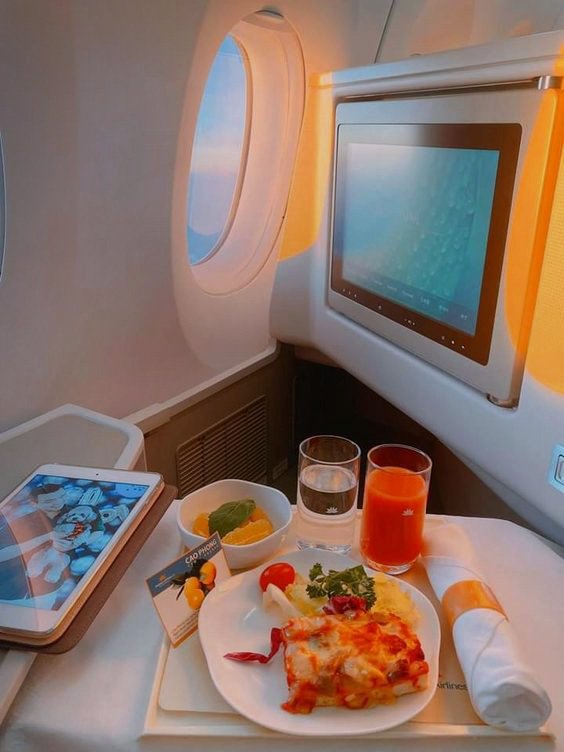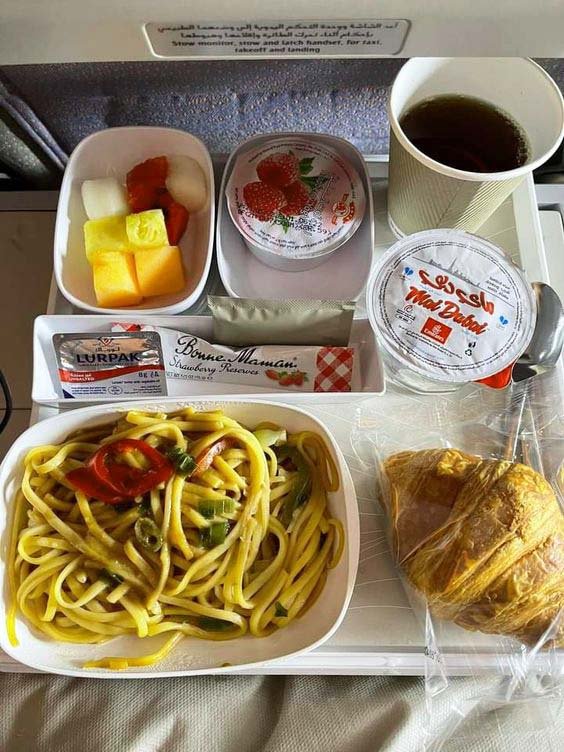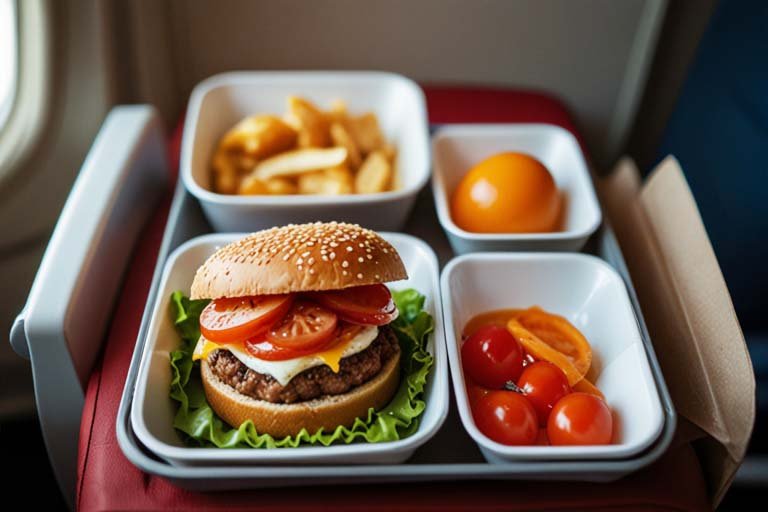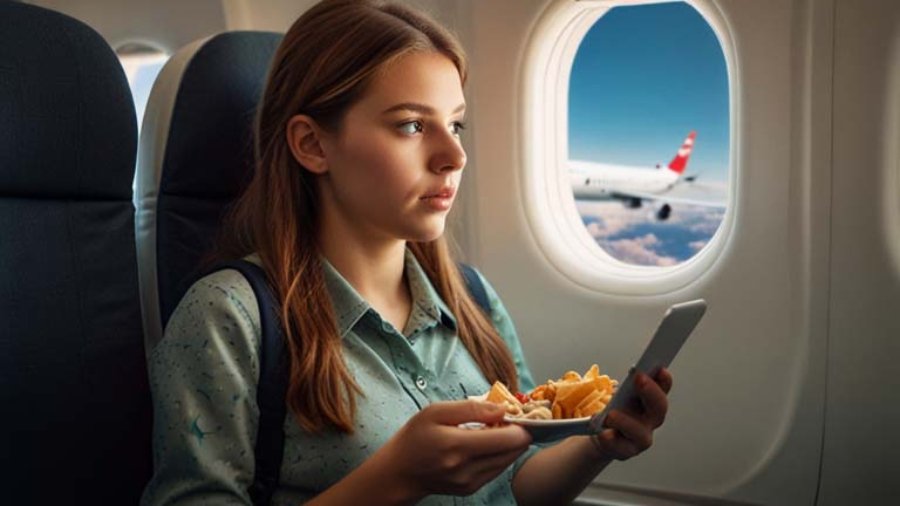When boarding a flight, many travelers often wonder what to expect when it comes to the onboard dining experience. Flight food, while essential for long-haul journeys, has gained a reputation over the years for being either an unexpected delight or a source of dissatisfaction. Whether you’re flying in economy or first class, understanding how food is prepared, the challenges faced by airlines, and how to make the best of your inflight meals can greatly enhance your overall travel experience. In this article, we’ll cover everything you need to know about eating on planes, from the science behind flight food to tips for getting the most out of your meals.

Table of Contents
How Flight Food is Prepared
Behind-the-Scenes Look at Catering
The preparation of flight food is a complex operation that takes place in high-tech catering facilities near airports. These facilities operate under strict hygiene and safety standards to ensure the food remains safe for consumption at high altitudes. Meals are designed and prepared long before they reach the plane, with chefs carefully crafting menus that are both flavorful and safe for storage. The cooking process typically involves preparing the meals to be slightly undercooked, as they will later be reheated onboard the aircraft.
Once cooked, the meals are rapidly cooled to maintain freshness and then packaged into containers. Every meal is labeled and stored according to its serving time and class designation (e.g., economy, business, or first class). The attention to detail in preparing flight food ensures that passengers can enjoy a fresh, hot meal even after hours of flying.
How Meals are Stored and Served Onboard
After the meals are prepared and packaged, they are transported to the airport in temperature-controlled trucks. Upon arrival, the flight food is loaded into the aircraft’s galleys, which are equipped with specialized ovens and refrigerators. Depending on the flight’s duration and service class, meals are stored either chilled or frozen until they are ready to be reheated and served to passengers.
Flight attendants use built-in ovens to warm the meals to the appropriate serving temperature. These ovens are designed to heat the food evenly without overcooking it, ensuring that the meals taste fresh. Meals are then plated (in premium cabins) or handed out in pre-packaged trays to economy passengers. The challenge of serving hot, tasty food at high altitudes has led airlines to develop efficient systems for storing and reheating flight food during flights.
Why Flight Food Tastes Different

Ever notice how flight food tastes different than what you might expect on the ground? This isn’t your imagination. The cabin environment, particularly the lower air pressure and reduced humidity, affects our senses of taste and smell. At 30,000 feet, your taste buds become less sensitive to sweet and salty flavors, and your sense of smell, which plays a big role in how we experience food, is also dulled.
To counteract this, airlines modify their recipes by adding stronger seasonings or umami flavors, which tend to be less affected by altitude. In some cases, meals are prepared with more salt and spices than usual to ensure they don’t taste bland once served at cruising altitude. Additionally, the dry cabin air can further affect how we perceive flavors, making the challenge of creating palatable flight food even more complex.
Different Classes, Different Meals
One of the most significant factors that influence the quality of flight food is the class you’re flying in. Here’s a breakdown of what you can expect in each class:
1. Economy Class
Economy class meals are often mass-produced, with limited options. You might receive a tray containing a main dish, a side (such as salad or fruit), a bread roll, and dessert. The food may not be as elaborate, but airlines still try to accommodate various dietary preferences by offering vegetarian, vegan, or kosher options. While budget airlines often don’t include meals in the ticket price, many full-service airlines provide complimentary meals on long-haul flights.
2. Business Class
In business class, the food experience is elevated. Meals are served on proper dishes with real cutlery, and the selection is broader, often including multiple courses and options such as gourmet cheeses, salads, and dessert. Business class passengers might also have access to a wider range of beverages, including premium wines and liquors.
3. First Class
First class dining is a luxury experience. In addition to high-quality ingredients and more refined presentation, some airlines even offer dine-on-demand services, where passengers can order food whenever they like. First-class menus often feature dishes created by world-renowned chefs, and airlines take pride in offering locally sourced ingredients and a variety of international cuisine options.
Flight Food for Long-Haul and Short-Haul Flights
The type and quantity of flight food you’ll receive largely depend on the length of your flight. On short-haul flights, especially those under two hours, you might receive a small snack or a drink, though some airlines have eliminated free snacks altogether on shorter routes. For flights over two hours, a more substantial meal is typically served, which might be a cold sandwich, salad, or a hot meal.
On long-haul flights, particularly international ones, passengers are usually served multiple meals throughout the journey. The longer the flight, the more elaborate the meal service. You can expect a full dinner, followed by breakfast or a light snack before landing. Airlines also provide additional snacks between meal services, particularly on flights lasting over eight hours.
How to Pre-Order Flight Food
Many airlines now offer the option to pre-order your flight food online before your flight. This service ensures you get your meal of choice, as popular options can sometimes run out, particularly in economy class. Pre-ordering is especially useful for passengers with specific dietary requirements or preferences, such as vegetarian, gluten-free, or halal meals.
To pre-order, simply visit the airline’s website or mobile app, enter your flight details, and select from the available meal options. Most airlines allow you to choose your meal at least 24 hours before departure. This service is typically available for both economy and premium cabins, giving all passengers a chance to customize their in-flight dining experience.
Can You Bring Your Own Food on Planes?
If you’re not keen on the flight food provided or have very specific dietary preferences, you’re welcome to bring your own food onboard most flights. However, there are a few things to keep in mind. Liquids and semi-liquid foods like soups, yogurts, or sauces must comply with TSA liquid restrictions if you’re flying from the U.S. Solid foods like sandwiches, fruits, and snacks are generally allowed.
Keep in mind that food brought from home won’t be reheated onboard, so make sure to bring something that can be enjoyed cold. Additionally, be mindful of strong-smelling foods, as other passengers may find the aroma disruptive in the confined space of an airplane cabin.
Tips for Enjoying Flight Food
Despite the challenges of eating at high altitudes, there are several ways to improve your inflight dining experience. Here are some helpful tips:
1. Pre-Order Special Meals
If you have dietary restrictions or preferences, ordering a special meal can be a good strategy. Not only will you get a meal that caters to your needs, but special meals are often served first, so you can eat earlier than the rest of the cabin.
2. Stay Hydrated
Drink plenty of water during your flight. Dehydration is one of the leading causes of discomfort when eating on planes, so avoiding alcohol and caffeine can help improve your overall experience.
3. Pack Your Own Snacks
If you’re flying on a budget airline or have a long layover, packing your own snacks can be a lifesaver. Fruits, nuts, energy bars, and sandwiches are great options that will keep you full and satisfied.
4. Choose Your Seat Wisely
If meal service is important to you, selecting a seat closer to the front of the cabin can increase your chances of getting your preferred meal option before it runs out.
5. Go for Protein and Fiber
Meals high in protein and fiber can help keep you full for longer. This is especially important on long-haul flights where meals may be spread out over several hours.

Flight food has come a long way, and while the experience can vary depending on the airline, class, and route, understanding the unique challenges of dining at 35,000 feet can help set realistic expectations. Whether you’re in economy or first class, a little preparation and a good mindset can turn inflight dining into a pleasant part of your journey.
Enjoy your next meal in the sky!


маркетплейс аккаунтов магазин аккаунтов социальных сетей
маркетплейс аккаунтов купить аккаунт
профиль с подписчиками https://magazin-akkauntov-online.ru/
маркетплейс аккаунтов соцсетей маркетплейс аккаунтов соцсетей
купить аккаунт маркетплейс аккаунтов соцсетей
магазин аккаунтов https://kupit-akkaunt-top.ru/
купить аккаунт гарантия при продаже аккаунтов
Purchase Ready-Made Accounts https://buyverifiedaccounts001.com/
Gaming account marketplace Sell accounts
Account Acquisition Account Buying Platform
Account market Account trading platform
Account Store Secure Account Purchasing Platform
Purchase Ready-Made Accounts Buy accounts
Database of Accounts for Sale Verified Accounts for Sale
Online Account Store Account Trading Service
Account Trading Platform https://buyaccounts001.com/
Account Purchase Profitable Account Sales
secure account sales purchase ready-made accounts
buy and sell accounts buy pre-made account
sell accounts account sale
account trading platform sell accounts
gaming account marketplace account acquisition
account selling service buy pre-made account
account selling platform secure account purchasing platform
account trading platform account buying service
accounts marketplace account buying platform
account trading platform buy pre-made account
account exchange service social media account marketplace
find accounts for sale account trading service
buy pre-made account https://accounts-buy.org
account market account exchange
account acquisition account market
account buying service accounts for sale
account market sell account
buy account find accounts for sale
account trading website for buying accounts
secure account purchasing platform account trading
online account store account trading platform
secure account purchasing platform account selling platform
accounts market account exchange
account selling platform sell account
account selling service accounts market
sell pre-made account account store
account selling platform account sale
account trading service buy and sell accounts
account acquisition https://accounts-offer.org
account store https://accounts-marketplace.xyz
account sale https://buy-best-accounts.org
account trading service account marketplace
buy accounts account market
gaming account marketplace https://buy-accounts.space
account trading platform https://buy-accounts-shop.pro
account store https://buy-accounts.live
sell account https://accounts-marketplace.online
account sale https://accounts-marketplace-best.pro
купить аккаунт akkaunty-na-prodazhu.pro
магазин аккаунтов rynok-akkauntov.top
покупка аккаунтов kupit-akkaunt.xyz
маркетплейс аккаунтов соцсетей akkaunt-magazin.online
биржа аккаунтов akkaunty-market.live
маркетплейс аккаунтов kupit-akkaunty-market.xyz
маркетплейс аккаунтов соцсетей https://akkaunty-optom.live/
маркетплейс аккаунтов https://online-akkaunty-magazin.xyz/
магазин аккаунтов https://akkaunty-dlya-prodazhi.pro
продажа аккаунтов kupit-akkaunt.online
buy facebook ad accounts buy a facebook ad account
buy fb account buy fb account
facebook ad account for sale buy old facebook account for ads
buy facebook ads accounts buy facebook ad account
buy facebook ad accounts buy facebook ad accounts
buy facebook ads manager https://ad-account-for-sale.top
Эта информационная заметка содержит увлекательные сведения, которые могут вас удивить! Мы собрали интересные факты, которые сделают вашу жизнь ярче и полнее. Узнайте нечто новое о привычных аспектах повседневности и откройте для себя удивительный мир информации.
Углубиться в тему – https://medalkoblog.ru/
buy a facebook ad account https://buy-ad-account.click
buy facebook accounts cheap https://ad-accounts-for-sale.work
old google ads account for sale https://buy-ads-account.top
buy adwords account https://buy-ads-accounts.click
buy facebook profile https://buy-accounts.click
buy adwords account https://ads-account-for-sale.top
adwords account for sale buy google ads account
buy google ads threshold account https://buy-ads-invoice-account.top
buy google ads account buy-account-ads.work
buy aged google ads account https://buy-ads-agency-account.top/
buy google adwords account https://sell-ads-account.click
google ads account for sale https://ads-agency-account-buy.click
facebook bm for sale https://buy-business-manager.org/
buy verified google ads account https://buy-verified-ads-account.work
buy bm facebook buy-bm-account.org
buy facebook ads accounts and business managers https://buy-business-manager-acc.org/
buy verified bm facebook buy-verified-business-manager-account.org
buy facebook verified business account buy-verified-business-manager.org
facebook bm for sale https://business-manager-for-sale.org
verified facebook business manager for sale buy-business-manager-verified.org
buy verified facebook https://buy-bm.org/
facebook business manager for sale https://verified-business-manager-for-sale.org
business manager for sale https://buy-business-manager-accounts.org
tiktok agency account for sale https://buy-tiktok-ads-account.org
tiktok ads account buy https://tiktok-ads-account-buy.org
buy tiktok ad account https://tiktok-ads-account-for-sale.org
tiktok ads agency account https://tiktok-agency-account-for-sale.org
tiktok ads agency account https://buy-tiktok-ad-account.org
tiktok ad accounts https://buy-tiktok-ads-accounts.org
buy tiktok ad account https://tiktok-ads-agency-account.org
tiktok ads account for sale https://buy-tiktok-business-account.org
buy tiktok ads accounts https://buy-tiktok-ads.org
I don’t think the title of your article matches the content lol. Just kidding, mainly because I had some doubts after reading the article.
buy facebook ads accounts buy account account trading platform
buy facebook accounts cheap buy accounts purchase ready-made accounts
Pinco giriş çox asandır və sürətli işləyir.
Pinco kazinosunun mobil versiyası istənilən cihazda işləyir.
Pinco casino az yeni oyunçular üçün xoş gəlmisiniz bonusu verir.
Pinco casino apk ilə rahat oyun təcrübəsi yaşayacaqsan.
Pinco oyunu real vaxt rejimində təqdim olunur.
Pinco casino apk təhlükəsizlik və sürətə zəmanət verir.
Pinco casino tətbiqi sürətli yüklənir və dərhal işləyir.
Pinco giriş zamanı heç bir problem yaşamazsınız.
Pinco casino apk mobil oyun üçün ideal vasitədir https://pinco-casino-azerbaijan-online.com/az.
ремонт кофемашины филипс срочный ремонт кофемашин
ПОмощь юрист в банкротстве: банкротство ооо
Ремонт кофемашин https://coffee-craft.kz с выездом на дом или в офис. Диагностика, замена деталей, настройка. Работаем с бытовыми и профессиональными моделями. Гарантия качества и доступные цены.
Круглосуточный алкоголизм вывод из запоя — помощь на дому и в стационаре. Капельницы, очищение организма, поддержка сердца и нервной системы. Анонимно и конфиденциально.
Купить мебель угловые прихожие для дома и офиса по выгодным ценам. Широкий выбор, стильный дизайн, высокое качество. Доставка и сборка по всей России. Создайте комфорт и уют с нашей мебелью.
Weekend logistics simplified: a robust rockbros bike rack gets you from driveway to dirt without improvising with bungee cords.
Предлагаем оконные профили https://proizvodstvo-okonnych-profiley.ru для застройщиков и подрядчиков. Высокое качество, устойчивость к климатическим нагрузкам, широкий ассортимент.
Оконные профили https://proizvodstvo-okonnych.ru для застройщиков и подрядчиков по выгодным ценам. Надёжные конструкции, современные материалы, поставка напрямую с завода.
вопрос юристу москва юридическая консультация круглосуточно
Нужны пластиковые окна: пластиковые окна недорого цена
Нужен вентилируемый фасад: https://podsistema-dlya-ventfasada.ru
Trust Finance https://trustf1nance.com is your path to financial freedom. Real investments, transparent conditions and stable income.
ceramic flowers clay flowers
Інформаційний портал https://pizzalike.com.ua про піцерії та рецепти піци в Україні й світі. Огляди закладів, адреси, меню, поради від шефів, секрети приготування та авторські рецепти. Все про піцу — від вибору інгредієнтів до пошуку найсмачнішої у вашому місті.
Решили купить Honda? проверьте свой автомобиль широкий ассортимент автомобилей Honda, включая новые модели, такие как Honda CR-V и Honda Pilot, а также автомобили с пробегом. Предоставляем услуги лизинга и кредитования, а также предлагает различные акции и спецпредложения для корпоративных клиентов.
Ищешь автозапчасти? автообзоры онлайн предоставляем широкий ассортимент автозапчастей, автомобильных аксессуаров и оборудования как для владельцев легковых автомобилей, так и для корпоративных клиентов. В нашем интернет-магазине вы найдете оригинальные и неоригинальные запчасти, багажники, автосигнализации, автозвук и многое другое.
Выкуп автомобилей https://restyle-avto.ru/ без постредников, быстро. . У нас вы можете быстро оформить заявку на кредит, продать или купить автомобиль на выгодных условиях, воспользовавшись удобным поиском по марке, модели, приводу, году выпуска и цене — независимо от того, интересует ли вас BMW, Hyundai, Toyota или другие популярные бренды.
продвижение сайтов seo продвижение сайта любой тематики. Поисковая оптимизация, рост органического трафика, улучшение видимости в Google и Яндекс. Работаем на результат и долгосрочный эффект.
нужен юрист: арбитражный юрист защита интересов, составление договоров, сопровождение сделок, помощь в суде. Опыт, конфиденциальность, индивидуальный подход.
audiodateien zusammenfuhren audio rauschunterdruckung
Заказать такси https://taxi-sverdlovsk.ru онлайн быстро и удобно. Круглосуточная подача, комфортные автомобили, вежливые водители. Доступные цены, безналичная оплата, поездки по городу и за его пределы
Онлайн-заказ такси https://sverdlovsk-taxi.ru за пару кликов. Быстро, удобно, безопасно. Подача в течение 5–10 минут, разные классы авто, безналичный расчет и прозрачные тарифы.
Закажите такси https://vezem-sverdlovsk.ru круглосуточно. Быстрая подача, фиксированные цены, комфорт и безопасность в каждой поездке. Подходит для деловых, туристических и семейных поездок.
Быстрый заказ такси https://taxi-v-sverdlovske.ru онлайн и по телефону. Подача от 5 минут, комфортные автомобили, безопасные поездки. Удобная оплата и выгодные тарифы на любые направления.
Платформа пропонує https://61000.com.ua різноманітний контент: порадник, новини, публікації на тему здоров’я, цікавих історій, місць Харкова, культурні події, архів статей та корисні матеріали для жителів міста
Нужен сантехник: сантехник алматы недорого
Saznajte sve o https://www.kamen-u-bubregu.com – simptomi, uzroci i efikasni nacini lecenja. Procitajte savete strucnjaka i iskustva korisnika, kao i preporuke za prevenciju i brzi oporavak.
ГОРСВЕТ Чебоксары https://gorsvet21.ru эксплуатация, ремонт и установка систем уличного освещения. Качественное обслуживание, модернизация светильников и энергоэффективные решения.
Займы онлайн лайк займ вход моментальное оформление, перевод на карту, прозрачные ставки. Получите нужную сумму без визита в офис и долгих проверок.
Интернет-магазин мебели https://mebelime.ru тысячи моделей для дома и офиса. Гарантия качества, быстрая доставка, акции и рассрочка. Уют в каждый дом.
Форум общения вирт секс многие им занимаются, спрашивают за и против, кто то делится своим опытом, пишут подписчики.
Zasto se javlja bol u bubrezima: od kamenaca i infekcija do prehlade. Kako prepoznati opasne simptome i brzo zapoceti lecenje. Korisne informacije.
Авто журнал https://bestauto.kyiv.ua свежие новости автопрома, тест-драйвы, обзоры новинок, советы по уходу за автомобилем и репортажи с автособытий.
Sta znaci https://www.pesak-u-bubregu.com, koji simptomi ukazuju na problem i kako ga se resiti. Efikasni nacini lecenja i prevencije.
Популярный авто журнал https://mirauto.kyiv.ua подробные обзоры моделей, советы экспертов, новости автосалонов и автоспорта, полезные статьи для автовладельцев.
delivery new york city https://delivery-new-york.com
Ручка флешка подарочная флешка купить Спб оптом купить в розницу и интернет Магазин флешек в Ялте. Криптофлешка купить и чехол На флешку в Нижнем Тагиле. Флешка оптом На фотоаппарат и купить флешку для фотоаппарата Canon
Экономические новости https://gau.org.ua прогнозы и обзоры. Политика, бизнес, финансы, мировые рынки. Всё, что важно знать для принятия решений.
Мужской портал https://hooligans.org.ua всё, что интересно современному мужчине: стиль, спорт, здоровье, карьера, автомобили, технологии и отдых. Полезные статьи и советы каждый день.
Онлайн авто портал https://avtomobilist.kyiv.ua с обзорами новых и подержанных авто, тест-драйвами, советами по обслуживанию и новостями из мира автопрома.
Портал о строительстве https://juglans.com.ua свежие новости, статьи и советы. Обзоры технологий, материалов, дизайн-идеи и практические рекомендации для профессионалов и частных застройщиков.
Строительный портал https://dki.org.ua всё о строительстве и ремонте: технологии, оборудование, материалы, идеи для дома. Новости отрасли и экспертные рекомендации.
Онлайн строительный https://texha.com.ua портал о материалах, проектах и технологиях. Всё о ремонте, строительстве и обустройстве дома. Поддержка специалистов и вдохновение для новых идей.
Всё о стройке https://mramor.net.ua полезные статьи, советы, обзоры материалов и технологий. Ремонт, строительство домов, дизайн интерьера и современные решения для вашего проекта.
Сайт «Всё о стройке» https://sushico.com.ua подробные инструкции, советы экспертов, новости рынка. Всё о строительстве, ремонте и обустройстве жилья в одном месте.
Онлайн женский https://ledis.top сайт о стиле, семье, моде и здоровье. Советы экспертов, обзоры новинок, рецепты и темы для вдохновения. Пространство для современных женщин.
nyc freight freight shipping new york
оценка лицензии услуга оценки
vps hosting vps hosting
стул мастера педикюра кушетка косметологическая на гидравлике
куб бетона саратов бетон
https://newskor.com.ua/znachennia-imeni-daniel-vidkryyte-taiemnytsi-ta-kharakterystyku-imeni/
bazaindex.ru
https://kaztur.ru/
pocket options ile güvenle işlem yapmaya başlayın ve sezgisel ve güçlü bir platformdan yararlanın!
https://cataractspb.ru/
топ накрутка подписчиков тг
Inizia a fare trading in tutta sicurezza con download pocket option for android e goditi una piattaforma intuitiva e potente!
уход за кожей beautyhealthclub.ru
Хочу порекомендовать вам телеграм группу для знакомств с девушками в Новосибирске где участницы охотно общаются делятся советами по встречам проводятся тематические мероприятия и есть модерация чтобы новые контакты были безопасными приятными и продуктивными – https://t.me/prostitutki_novosibirsk_indi
эфирные масла aromatmaslo
https://foodexpert.pro/interesnoe/obuchenie/kak-uchit-angliyskiy-yazyk-detyam-10-13-let-sovety-dlya-roditeley-i-prepodavateley.html
духи герлен
мавпячий правопис
Фракционный лазер, химические пилинги и филлеры: узнайте, какой метод подойдет для вашего метода работы: мезотерапия препараты цены
духи с сандалом
https://moskva-restoran.ru/
Thank you for your sharing. I am worried that I lack creative ideas. It is your article that makes me full of hope. Thank you. But, I have a question, can you help me? https://www.binance.info/ru-UA/register-person?ref=OMM3XK51
https://avtoinstruktor177.ru/
https://widget-free-2x.org/
Цены на ремонт https://remontkomand.kz/ru/price квартир и помещений в Алматы под ключ. Узнайте точные расценки на все виды работ — от демонтажа до чистовой отделки. Посчитайте стоимость своего ремонта заранее и убедитесь в нашей прозрачности. Никаких «сюрпризов» в итоговой смете!
https://t.me/ruscasino_top
Планируете ремонт https://remontkomand.kz в Алматы и боитесь скрытых платежей? Опубликовали полный и честный прайс-лист! Узнайте точные расценки на все виды работ — от демонтажа до чистовой отделки. Посчитайте стоимость своего ремонта заранее и убедитесь в нашей прозрачности. Никаких «сюрпризов» в итоговой смете!
https://prokatvrf.ru/
https://bazis-foam.ru/
СОЛАРТЕК Москва